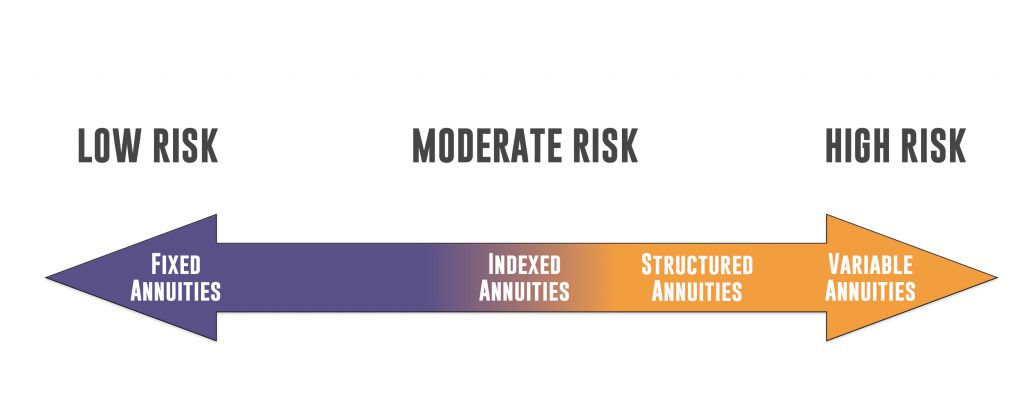All Categories
Featured
Table of Contents
The settlement could be spent for growth for a long period of timea solitary premium deferred annuityor invested for a short time, after which payment beginsa solitary costs instant annuity. Single premium annuities are frequently moneyed by rollovers or from the sale of a valued possession. A flexible costs annuity is an annuity that is meant to be moneyed by a series of settlements.
Owners of repaired annuities know at the time of their purchase what the value of the future capital will certainly be that are produced by the annuity. Certainly, the variety of cash flows can not be understood in advance (as this depends upon the contract proprietor's lifespan), however the guaranteed, fixed rate of interest at the very least provides the proprietor some degree of assurance of future earnings from the annuity.
While this distinction seems easy and simple, it can substantially influence the worth that a contract owner eventually originates from his/her annuity, and it creates substantial uncertainty for the agreement proprietor - Fixed annuity contracts. It additionally generally has a product influence on the degree of costs that a contract owner pays to the issuing insurance firm
Set annuities are typically used by older investors who have restricted properties yet that wish to offset the danger of outliving their assets. Set annuities can work as an effective device for this function, though not without specific drawbacks. For instance, when it comes to prompt annuities, once an agreement has actually been purchased, the agreement proprietor relinquishes any type of and all control over the annuity properties.
Breaking Down Fixed Index Annuity Vs Variable Annuity Key Insights on Your Financial Future Breaking Down the Basics of Investment Plans Advantages and Disadvantages of Different Retirement Plans Why Variable Annuities Vs Fixed Annuities Matters for Retirement Planning How to Compare Different Investment Plans: Simplified Key Differences Between Different Financial Strategies Understanding the Rewards of Variable Vs Fixed Annuity Who Should Consider Fixed Vs Variable Annuity Pros And Cons? Tips for Choosing the Best Investment Strategy FAQs About Planning Your Financial Future Common Mistakes to Avoid When Choosing Fixed Income Annuity Vs Variable Annuity Financial Planning Simplified: Understanding Variable Vs Fixed Annuity A Beginner’s Guide to Smart Investment Decisions A Closer Look at Fixed Index Annuity Vs Variable Annuities
A contract with a typical 10-year abandonment duration would bill a 10% abandonment cost if the agreement was given up in the first year, a 9% surrender cost in the second year, and so on until the abandonment charge gets to 0% in the contract's 11th year. Some deferred annuity agreements consist of language that enables tiny withdrawals to be made at various intervals throughout the abandonment duration scot-free, though these allowances commonly come with a cost in the form of lower surefire rates of interest.
Simply as with a fixed annuity, the proprietor of a variable annuity pays an insurance provider a swelling sum or series of settlements in exchange for the pledge of a collection of future repayments in return. As mentioned over, while a fixed annuity expands at a guaranteed, continuous price, a variable annuity grows at a variable rate that depends upon the performance of the underlying investments, called sub-accounts.
Throughout the accumulation stage, possessions bought variable annuity sub-accounts grow on a tax-deferred basis and are taxed just when the agreement proprietor takes out those profits from the account. After the build-up stage comes the earnings stage. With time, variable annuity possessions must in theory boost in value until the agreement proprietor chooses she or he wish to start withdrawing cash from the account.
One of the most substantial issue that variable annuities commonly present is high expense. Variable annuities have several layers of charges and costs that can, in accumulation, create a drag of as much as 3-4% of the contract's value every year. Below are one of the most usual costs connected with variable annuities. This expenditure makes up the insurance provider for the risk that it assumes under the regards to the agreement.
M&E cost costs are determined as a percentage of the contract value Annuity companies pass on recordkeeping and other management expenses to the agreement owner. This can be in the form of a level annual fee or a percent of the contract value. Administrative costs may be included as component of the M&E risk cost or might be examined individually.
These fees can range from 0.1% for passive funds to 1.5% or even more for proactively taken care of funds. Annuity agreements can be customized in a number of ways to offer the specific requirements of the contract owner. Some common variable annuity riders consist of ensured minimum accumulation advantage (GMAB), assured minimum withdrawal benefit (GMWB), and guaranteed minimum revenue advantage (GMIB).
Breaking Down Fixed Income Annuity Vs Variable Growth Annuity A Comprehensive Guide to Fixed Interest Annuity Vs Variable Investment Annuity Defining Fixed Vs Variable Annuities Features of Smart Investment Choices Why Choosing the Right Financial Strategy Is Worth Considering Deferred Annuity Vs Variable Annuity: How It Works Key Differences Between Variable Vs Fixed Annuities Understanding the Risks of Long-Term Investments Who Should Consider Strategic Financial Planning? Tips for Choosing Fixed Indexed Annuity Vs Market-variable Annuity FAQs About Planning Your Financial Future Common Mistakes to Avoid When Choosing a Financial Strategy Financial Planning Simplified: Understanding Tax Benefits Of Fixed Vs Variable Annuities A Beginner’s Guide to Smart Investment Decisions A Closer Look at Indexed Annuity Vs Fixed Annuity
Variable annuity contributions offer no such tax obligation reduction. Variable annuities have a tendency to be highly ineffective lorries for passing riches to the next generation because they do not take pleasure in a cost-basis adjustment when the original contract owner passes away. When the proprietor of a taxed investment account passes away, the price bases of the investments kept in the account are gotten used to reflect the market prices of those financial investments at the time of the proprietor's death.
As a result, heirs can inherit a taxed investment profile with a "fresh start" from a tax obligation viewpoint. Such is not the case with variable annuities. Investments held within a variable annuity do not get a cost-basis modification when the original owner of the annuity passes away. This indicates that any collected unrealized gains will be handed down to the annuity owner's heirs, along with the connected tax burden.

One considerable concern associated with variable annuities is the capacity for problems of interest that may feed on the part of annuity salespeople. Unlike an economic advisor, who has a fiduciary responsibility to make investment decisions that benefit the customer, an insurance policy broker has no such fiduciary obligation. Annuity sales are highly financially rewarding for the insurance coverage specialists that market them due to the fact that of high ahead of time sales compensations.
Many variable annuity agreements contain language which puts a cap on the percentage of gain that can be experienced by particular sub-accounts. These caps stop the annuity proprietor from fully joining a section of gains that can otherwise be enjoyed in years in which markets produce significant returns. From an outsider's perspective, it would seem that capitalists are trading a cap on investment returns for the abovementioned ensured flooring on investment returns.
Understanding Fixed Income Annuity Vs Variable Annuity A Comprehensive Guide to Fixed Vs Variable Annuity Pros Cons Defining Indexed Annuity Vs Fixed Annuity Features of Smart Investment Choices Why Choosing the Right Financial Strategy Matters for Retirement Planning How to Compare Different Investment Plans: A Complete Overview Key Differences Between Fixed Index Annuity Vs Variable Annuity Understanding the Rewards of Fixed Income Annuity Vs Variable Annuity Who Should Consider Variable Vs Fixed Annuity? Tips for Choosing Fixed Index Annuity Vs Variable Annuities FAQs About Planning Your Financial Future Common Mistakes to Avoid When Choosing Variable Annuity Vs Fixed Annuity Financial Planning Simplified: Understanding Your Options A Beginner’s Guide to Fixed Indexed Annuity Vs Market-variable Annuity A Closer Look at Fixed Vs Variable Annuity Pros And Cons
As noted over, give up fees can badly restrict an annuity owner's capacity to relocate possessions out of an annuity in the early years of the contract. Even more, while most variable annuities enable contract owners to take out a specified quantity during the buildup stage, withdrawals yet quantity commonly result in a company-imposed charge.
Withdrawals made from a fixed rates of interest financial investment alternative could likewise experience a "market price modification" or MVA. An MVA adjusts the worth of the withdrawal to reflect any adjustments in interest rates from the moment that the cash was purchased the fixed-rate choice to the moment that it was taken out.

Rather frequently, also the salespeople that offer them do not totally understand just how they work, and so salespeople often take advantage of a customer's emotions to sell variable annuities instead of the qualities and viability of the products themselves. We believe that financiers must totally recognize what they own and how much they are paying to have it.
Nonetheless, the exact same can not be said for variable annuity assets held in fixed-rate investments. These possessions legitimately come from the insurer and would certainly therefore be at risk if the firm were to fall short. Any kind of assurances that the insurance policy firm has actually concurred to give, such as an ensured minimum income advantage, would certainly be in question in the occasion of a service failure.
Decoding How Investment Plans Work A Closer Look at Fixed Vs Variable Annuities What Is the Best Retirement Option? Benefits of Retirement Income Fixed Vs Variable Annuity Why Fixed Index Annuity Vs Variable Annuities Can Impact Your Future What Is A Variable Annuity Vs A Fixed Annuity: Simplified Key Differences Between Different Financial Strategies Understanding the Risks of Long-Term Investments Who Should Consider Fixed Income Annuity Vs Variable Annuity? Tips for Choosing the Best Investment Strategy FAQs About Planning Your Financial Future Common Mistakes to Avoid When Planning Your Retirement Financial Planning Simplified: Understanding Fixed Annuity Or Variable Annuity A Beginner’s Guide to Smart Investment Decisions A Closer Look at Fixed Vs Variable Annuities
Consequently, potential purchasers of variable annuities need to understand and consider the monetary condition of the providing insurer prior to becoming part of an annuity agreement. While the advantages and disadvantages of various sorts of annuities can be disputed, the actual concern bordering annuities is that of suitability. Simply put, the inquiry is: who should have a variable annuity? This question can be tough to respond to, offered the myriad variants available in the variable annuity cosmos, however there are some standard standards that can assist investors decide whether annuities ought to play a role in their economic strategies.
As the saying goes: "Purchaser beware!" This short article is prepared by Pekin Hardy Strauss, Inc. ("Pekin Hardy," dba Pekin Hardy Strauss Wealth Administration) for informative functions only and is not planned as an offer or solicitation for business. The details and information in this post does not comprise legal, tax, accountancy, financial investment, or other expert recommendations.
Table of Contents
Latest Posts
Analyzing Strategic Retirement Planning Everything You Need to Know About Fixed Interest Annuity Vs Variable Investment Annuity Defining the Right Financial Strategy Pros and Cons of Various Financial
Analyzing Strategic Retirement Planning Everything You Need to Know About Financial Strategies Breaking Down the Basics of Investment Plans Advantages and Disadvantages of Different Retirement Plans W
Exploring What Is Variable Annuity Vs Fixed Annuity A Closer Look at How Retirement Planning Works Defining the Right Financial Strategy Benefits of Tax Benefits Of Fixed Vs Variable Annuities Why Cho
More
Latest Posts